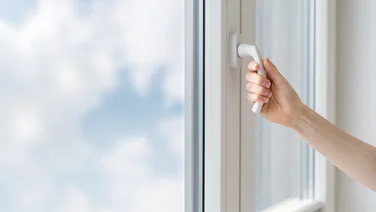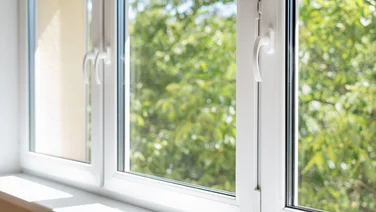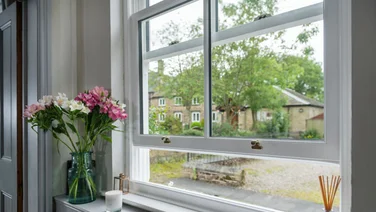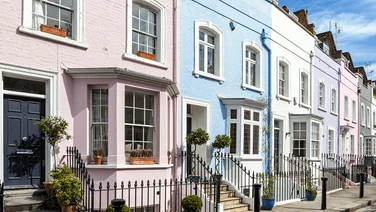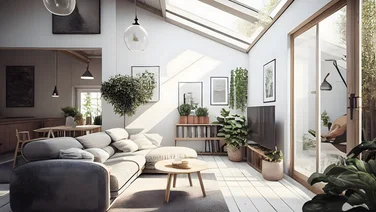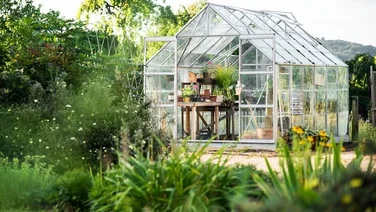- Can double glazing add value to my home?
- How does double glazing work?
- What type of double glazing is there?
- How can I tell which type of window I should get?
- When should I replace my double glazing?
- Are there any grants for double glazing?
- Do I need planning permission to install double glazing?
- What are the alternatives to double glazing?
- Summary
- Double glazing can help you cut emissions and lower your bills
- Double glazing can add value to your home, as it can help boost its EPC rating
- Double glazing lasts, on average, 20 years without substantial damage
- Secondary glazing is the most-popular alternative to double glazing

Double glazing has the potential to help you cut emissions and lower your bills. In the long-term, however, it can improve your home’s EPC rating, which in turn, can help increase your home’s value.
Installing double glazing is an investment, and in this guide, we explain if it’s worth it, based on the question: Does double glazing add value to your home?
We also cover the different types of double glazing, signs of wear and tear, and any available grants.
If you’re looking to install double glazing, fill in this form and our trusted suppliers will be in touch with a quote.
Can double glazing add value to my home?
Yes, double glazing can add value to your home, as it can help boost its EPC rating. This is because it can increase thermal insulation, cut condensation, reduce the chance of internal damage and keeps your home warm in the winter.
The value increase will likely be on a case-by-case basis, as there are other factors to consider, such as the condition of your home and whether you have any other forms of low-carbon technologies installed.
The fact that double glazing can have a positive effect on your energy bills, as well as reduce noise, can be appealing to any potential buyers.
As an example, installing an A-rated double glazing to windows in an entirely single-glazed semi-detached gas-heated property can save you around £120 a year and 380kg of carbon dioxide.
If you installed A++ rated double glazed windows, the savings could be up to £140 a year and you could save 420kg of carbon dioxide.
How does double glazing work?
According to Everest Windows, double glazing works by creating an air gap that insulates against heat transfer between two different temperature zones (inside and outside). This is achieved by two panes of glass sealed in a unit separated by a spacer bar.
“The space between the panes (usually 6-12mm) creates an air gap that slows down thermal transfer (hot or cold) by conduction – it doesn’t ‘trap heat’ but it slows down the movement of heat to reduce heat loss.
“Because air can’t circulate in the narrow gap between the panes, air convection is slowed down and this also reduces heat transfer” its website states.
If you want to know how much new windows might set you back, look at our double glazing cost calculator.
How does double glazing work?
According to Everest Windows, double glazing works by creating an air gap that insulates against heat transfer between two different temperature zones (inside and outside). This is achieved by two panes of glass sealed in a unit separated by a spacer bar.
“The space between the panes (usually 6-12mm) creates an air gap that slows down thermal transfer (hot or cold) by conduction – it doesn’t ‘trap heat’ but it slows down the movement of heat to reduce heat loss.
“Because air can’t circulate in the narrow gap between the panes, air convection is slowed down and this also reduces heat transfer” its website states.

What type of double glazing is there?
The good news is that with double-glazing windows, you have plenty of options:
- uPVC windows – uPVC windows are typically the most economical material and are low-maintenance. They cost around £500 per window to install.
- Wooden windows – Wooden windows are traditional, but tend to be limited to three styles: sash, casement and bay.
- Aluminum windows – These offer a sleek, modern, ultra-durable and 100% recyclable window, and tend to last the longest.
- Sash windows – Sash windows are two windows placed with one behind the other, and usually slide up and down, crossing over each other. Some have fixed panels, though.
- Casement windows – The most versatile frames used in UK homes. They have a variety of configurations to suit different properties and you have single, double and triple glazing
- Bay windows – These protrude from a building, adding more floor space or a window bay with a deep sill. These are some of the most-popular window choices for Victorian and Edwardian homes.
- Tile and turn windows – These are available in both uPVC and aluminum materials and let a lot of light into your home.
How can I tell which type of window I should get?
The EPC rating will likely be improved when you install double glazing, but it’s hard to determine which type will help the most, especially as other factors will influence this.
When it comes to choosing the right type, look at its energy rating and the u-value. The energy rating of double glazing is measured from A++ to £. Typically, A++ will give you the highest protection.
These windows that have an energy rating will also display a ‘u-rating’. This is a measure of how easily heat passes through a material, but it’s important to remember that this is just one part of the overall energy rating.
When should I replace my double glazing?
Double glazing lasts, on average, 20 years without substantial damage, but there are things to look out for in terms of general wear and tear:
- Condensation
- Noticeable draughts
- Chips or cracks
- Water leaks
- Increased noise
- Increased energy bills
Before you replace them, it’s worth getting a window company to come and review them. Get some quotes together and read reviews to make the right choice for you.
Are there any grants for double glazing?
There are five grants for double glazing available to help you with the cost of double glazing windows. These are:
- ECO4 and ECO Flex – This covers England, Scotland and Wales, and is specifically for low-income and fuel poor households. You’ll need to apply soon, though, as it’s due to end 31 March 2026.
- Home Upgrade Grant (now discontinued) – Now defunct, this grant was designed to help fund new windows, doors, and draught-proofing for UK homeowners. It is for low-income households and off-grid, low-energy efficiency-rated properties. The grant closed in March 2025 and has now been largely replaced with the Warm Homes Local Grant.
- Home Energy Scotland Grant and Loan – This is to help upgrade single glazing and is available to Scottish homeowners. There is no current closing date and is ongoing.
- Affordable Warmth Scheme – This grant is for Northern Ireland residents earning under £23,000 per annum to help draught-proof windows and doors and to replace single-glazed windows and doors
- Welsh Government Warm Homes Nest Scheme – Launched in 2011, this scheme is based on income-related benefits and properties with low energy performance rating, specific to Welsh residents only.

Do I need planning permission to install double glazing?
The short answer is planning permission is not required to replace windows and doors in dwelling houses, as long as the new items are ‘like for like in materials and appearance’.
The exception is if your property is covered by an Article 4 Direction, where you will then need planning permission in all instances. An Article 4 Direction is a planning legislation tool that allows a local planning authority or the secretary of state to remove certain permitted development rights in a specific area or property.
This means that planning permission is required for certain types of development that would not otherwise need an application.
The effect of an Article 4 direction removes development rights and in general planning applications, these properties are only approved when the change is like for like.
Planning permission is technically not needed for flats either, but check with your local authority, as each one will have their own rules around this.
You will, however, need planning permission if you’re looking to change a listed building.
What are the alternatives to double glazing?
If double glazing isn’t right for you or you want to consider alternatives, we’ve compiled a list of what else is available:
- Secondary glazing: Improves thermal insulation, stops noise pollution and adds security to your home. Types of secondary glazing include vertical sliding windows, horizontal sliding windows and fixed windows
- Retrofitting: Retrofitting is a very popular double-glazing alternative method. The process of retrofitting improves the energy efficiency, functionality and aesthetic appeal of your existing windows and doors just by removing the single pane of glass and replacing it with double glazing.
- Window inserts: This is where you add a secondary pane of glass to the interiors of existing window frames that create an additional layer of insulation in your windows.
- Install curtains and blinds: Although not a direct alternative, curtains and blinds can transfer heat and save energy to some extent.
What are the benefits to secondary glazing?
Secondary glazing is the most-popular alternative to double glazing. Here’s some of the benefits of secondary glazing:
- Thermal insulation: Allows you to add another layer of protection via windows against heat and energy loss
- Stop noise: If you live in a busy or loud building, secondary glazing can minimise outside noise by dampening sound waves
- Cost-effective: Secondary glazing allows you to enhance the performance of your existing windows without completely replacing them.
- Easy to install and remove: Secondary glazing rarely requires professional assistance, as it’s a fairly easy process to install them.
- Reduce condensation: As it adds a second layer of protection, it can aid in reducing condensation and potential damage to windows and other surfaces.
Summary
- Double glazing absolutely can add value to your home, and it has the potential to help you cut emissions and lower your bills. In the long-term, it can improve your home’s EPC rating.
- The value increase will likely be on a case-by-case basis, as there are other factors to consider, like the condition of your home and whether you have any other forms of low-carbon technologies installed.
- When it comes to determining the type, look at its energy rating and the u-value. The energy rating of double glazing is measured from A++ to £. Typically, A++ will give you the highest protection.
- Alternatives include secondary glazing, retrofitting, window inserts and curtain and blinds


